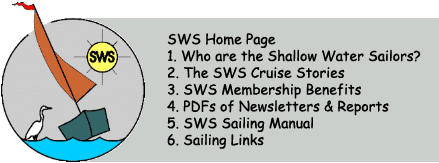| "The edge of the water is always exciting,
whether at the bottom of steep cliffs, or gleaming through forest, or on
the wide golden beaches of the mid-Atlantic coast." Two Islands by Katharine Scherman |
| Once you have
had the boat out on a few day trips and have gotten used to her, you begin
to think about cruising. In fact, when the boat is attached to your vehicle
you can almost imagine it as a little camping rig. After all with
your boat's cabin and tenting equipment you have a little home on wheels
that will do fine in a camp ground as you drive toward the body of water
you've been dreaming about. Then, when you finally arrive, you just pop
the boat in and now you can cruise for a few days or even a few weeks. |
4.1 Planning |
|
"Keep it simple" should be the overriding philosophy. You're out there to have fun and enjoy the watery world. You're not there for a gourmet meal nor to ring for room
service. Start off slowly. Take short trips first so that you
can refine your skills and personalize your approach to living on a small
boat. Keep your boat tidy. Find and make storage places for
everything, where everything has a place and everything is in its place.
Most SWS boats are truly trailerable boats, have cruising room
for only one or two people. Any more will make the cruise very tough. If
you have children, plan to take one out at a time out. An important part of planning is making various lists to be used in readying the boat and its stores. You need a driveway checklist that you use to assure your ready for the road, and you need a ramp checklist to assure you've configured the boat for launching, like remembering to install the boat's drain plug before launching! At home you need a provisions checklist to assure you got such things as enough fresh water aboard. Ray Aldridge's "The Essential Checklist" is a good start, use it to build your own personal list. Here is Ray's list in two forms: checklist.pdf (Portable Document Format from Adobe) checklist.doc (Word Document Format) Check out Ray's blog at: Ray's Blog |
4.2 Shelter |
| With the SWSers,
every square inch counts. For SWSer such as the Bay Hen can take two below,
the Bimini/tent combination gives the two crew members much more room to
spread out, making the time at anchor a pleasure. The Bay Hen can also be
modified to allow sleeping in the cockpit. This is a simple modification
where several boards fill in the foot well allowing the tallest of persons
to stretch out comfortably. Make sure you have well designed bug
netting for all openings. You do not want to spend a hot night without such
netting. This is a must. |
4.3 Cooking |
Most small boaters use camping equipment for their boat's culinary gear. Small camp stoves on the market such as the newer butane types are easy to use and work well. There are also a number of alcohol types that are satisfactory. Be very careful of the fuels. They should be stowed so that they will not be damaged. Pressurized fuel containers may leak. Check for leaks after each use and stow these in an outside, ventilated locker. Do not use a gasoline stove. While looking at camping gear check out the compact, nesting type pots and pans, they do well on a small Hen. You can collect your cutlery (knives, forks, spoons) and cooking utensils and store in a fabric "housewife", a flat piece of fabric with pockets for each utensil, that rolls up for stowing, opens out flat for use. Many of my boating comrades cruise without ice. They go warm. This eliminates the need of finding ice on long cruises. These sailors become expert in choosing canned or dried food, herbs, and long-keeping veggies and fruits to augment the canned stuff (and offset it with a touch of healthfulness). They drink warm beer or go with a little wine and a lot of water. Some substitute an orange drink on their cereal in place of milk! Or they use the super pasteurized milk that does not need to be kept cold until it's opened. If you are an ice person, go with the very largest blocks of ice possible. I have found some nice sized plastic containers that I fill with water and freeze. As the ice melts the water is used for drinking. Several days before the cruise determine the number of days out and make up a shopping list based on the number of breakfasts, lunches, and suppers on the water. Try to prepare, ahead of time, one pot meals that are frozen in plastic containers sized for one meal. Group food into categories, breakfasts, lunch, suppers, and snacks. Stow each category separately. |
